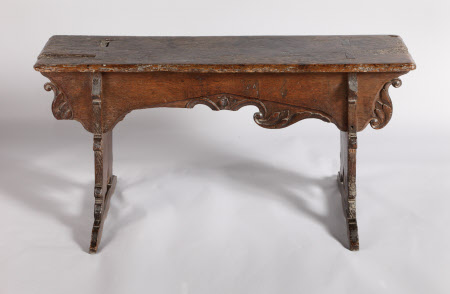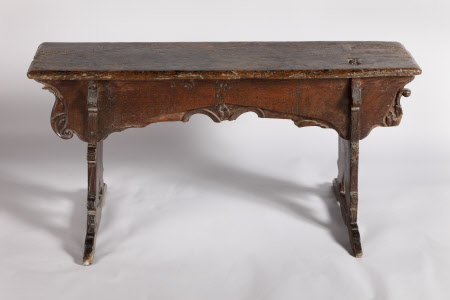Boarded stool
Category
Furniture
Date
circa 1540 - circa 1560
Materials
Carved and boarded oak
Measurements
55 x 108 x 28 cm
Place of origin
England
Order this imageCollection
Sizergh Castle, Cumbria
NT 998006
Summary
A rare carved and boarded oak stool, or form, English/Flemish, mid-16th century. Made of five boards, tenoned through with a pair inclined supports, with 'buttress'-type shaped edges and pierced with a cusped trefoil, the central upper cusp pointed. With later sledge-type feet. The inclined supports slotted to take two shaped apron boards, both with many losses but the ends carved with foliated 'S'-scrolls. The section of the apron between the supports with a sunken reserve in the form of a four-centred arch, also carved to its bottom edge with foliated scrolls and leaves.
Full description
This stool or form combines both Gothic - the cusped trefoils and the 'buttress-type edges to the supports - and Renaissance - the foliated scrolls edging and centering the aprons - features, which are typical of early Renaissance furniture and woodwork in England. It is possibly related to another seven forms at Sizergh - three of which bear the date 1562 - which have similar supports but friezes decorated with cusped 'frilly' aprons carved with scrolls, which are more obviously Renaissance in character. It is possible, therefore, that this form is their forerunner, an impression strengthened by the sunken reserve in the form of a four-centred arch to the aprons. When Walter Strickland died in 1569 an inventory of his goods listed two sets of 'iiii. short furmes', one in 'the lawe [low] tower', and the other 'in the chamber next Mr. Tempast chamber where thei dyne'. Whilst the former were valued with a table, with only one value being supplied, the latter were valued at 6s, or 1s 6d each. These eight short forms which survive are traditionally identified with the seven forms with cusped aprons. If that is the case, then this form is difficult to identify on the inventory, since the only other similar pieces of furniture mentioned are the 'viii furmes' listed in the hall, which - not described as short - were presumably longer than the other seven. The three dated stools which form the set NT 998000 vary in width between 105cm and 126cm wide, and NT 998001 are all 107cm wide. This is only, therefore, 3cm wider than the shortest form, and is, in fact, less tall than the others. It is hard to see, therefore, how this form would not have been described as 'short' in the inventory. A publication of 1908 by Daniel Scott transcribes another document, taken on 28th June 1569, which lists the contents of some rooms, but groups other pieces by category under titles such as 'Woddewarke'. 17 'buffett forms' are listed, and a remarkable 37 'buffett stoyles newe and old'. The maker of these boarded stools or forms is unknown, but they were made both on the Continent and in England at this period. (Megan Wheeler, 2016)
Provenance
Probably commissioned by Walter Strickland (1516 - 1569) and/or Alice Strickland (c. 1520 - 1588), thence by descent, and given by Henry Hornyold Strickland (1890 – 1975) with Sizergh Castle and its estates in 1950.
References
Wells-Cole 1997 Anthony Wells-Cole, Art and Decoration in Elizabethan and Jacobean England: the influence of continental prints, 1558-1625, New Haven & London 1997, p. 21 [Raine, 1853] James Raine, Wills and Inventories from the Registry of the Archdeaconry of Richmond (1853), pp. 221 and 222 Goodall, 2002: Ian Goodall. “Privacy, display and over extension: Walter Strickland’s rebuilding of Sizergh.” Antiquaries Journal 82 (2002): pp.197-245. Scott (1908), Daniel Scott, The Stricklands of Sizergh Castle, p. 109

